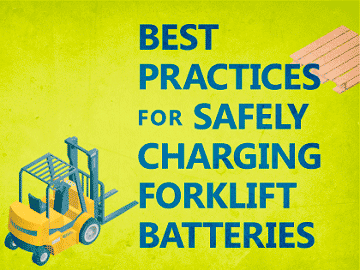- Home
- Loss Control
- Loss Control Insights
- Best Practices for Safely Charging Forklift Batteries
Wearing appropriate personal protective equipment (PPE) when connecting and disconnecting a battery charger from a battery or when servicing batteries is the most-misunderstood (and forgotten) step in charging forklift batteries. According to EMC Senior Engineer Paul Porter, it’s common for PPE to be stashed in a corner, covered in dust, or even missing from the battery-charging area. There may be several reasons why workers fail to put on the proper gear before working with forklift batteries:
- Many organizations hire outside vendors to check batteries, add water and sulfuric acid and perform other battery-related services. Because of this outsourcing of responsibilities, an organization’s employees may mistakenly assume that all other battery maintenance is safe to perform without precautions.
- It’s tempting to take shortcuts during busy times. An employee juggling multiple tasks may consider wearing PPE an annoyance, thinking he or she will save time by not wearing it.
Nuts and Bolts of PPE
Workers may not be aware that the sulfuric acid contained in batteries can cause severe injuries. Protective gear is the last line of defense against acid and other hazards such as exploding batteries. At a minimum, employees should wear long-sleeve shirts, long pants and anti-fog safety goggles that form a tight seal around the eyes. In addition, a face shield may be necessary to provide additional eye and face protection, along with rubber or neoprene gloves and an apron.
Other Safety Steps
In addition to PPE, there are other precautions to take when charging batteries at your facility. You’ll need:
1. A designated area just for battery charging.
This space must be well-ventilated and properly equipped for safely handling small fires, acid spills and injuries, and also a way to call for help in case of emergency. At the very least, an eye-wash station (preferably a plumed eye wash/shower station) is essential. Whichever type you choose, be sure that the unit meets design requirements of ANSI/ISEA Z358.1 (American National Standard for Emergency Eyewash and Shower Equipment).
2. Written company safety policies and procedures.
As you develop or revise your battery charging safety policies and procedures, compare them to your equipment manufacturer’s recommendations and the information found on the OSHA eTool site. Review your policies and procedures annually to ensure you are following updated industry guidelines and best practices.
3. Training for all employees who work with batteries.
Even if you have an outside vendor performing routine battery maintenance, your onsite employees should understand the dangers of working with batteries. They should know how to safely charge batteries according to the manufacturer’s instructions, how to use the emergency eye wash station and what to do in case of an emergency.
Get in touch
Need help? We’re here for you! Whether you have questions or need personalized assistance, your local office is ready to support you.
Loss Control Insights
Stay informed with the latest news and receive actionable safety tips, all carefully curated by our team of experts.
